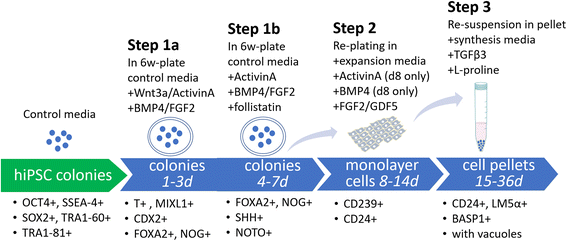|
|
|
|
|
一种促进人类诱导多能干细胞向髓核样细胞分化的新方法 | Stem Cell Research & Therapy |
|
|
论文标题:Differentiation of human induced pluripotent stem cells into nucleus pulposus-like cells
期刊:Stem Cell Research & Therapy
作者:Ruhang Tang, Liufang Jing, Vincent P. Willard, Chia-lung Wu, Farshid Guilak, Jun Chen and Lori A. Setton
发表时间:2018/03/09
数字识别码:10.1186/s13287-018-0797-1
原文链接:https://stemcellres.biomedcentral.com/articles/10.1186/s13287-018-0797-1?utm_source=WeChat&utm_medium=Social_media_organic&utm_content=DaiDen-MixedBrand-multijournal-Cell_Biology-China&utm_campaign=ORG_USG_BSCN_DD_Pluripotent_Stem_Cells_Collection
微信链接:https://mp.weixin.qq.com/s/M1olvJjfIDwsGWgWjr0ZYw
原文作者:Ruhang Tang, Liufang Jing, Vincent P. Willard, Chia-lung Wu, Farshid Guilak, Jun Chen and Lori A. Setton
椎间盘(IVD)退变的特征是早期髓核(NP)区域细胞数量减少,并伴有细胞外基质改变、水合作用减少和进行性退变。基于细胞的IVD治疗已成为一个备受关注的领域,有研究报告了多种细胞来源的再生潜能,包括自体或同种异体软骨细胞、原代IVD细胞和干细胞。然而,很少有方法具备促进NP表型的明确策略,一部分原因在于对该细胞系明确的标志物和分化方法的了解十分有限。
发表于Stem Cell Research & Therapy的Differentiation of human induced pluripotent stem cells into nucleus pulposus-like cells一文中,来自美国华盛顿大学的Lori A. Setton及其研究团队开发了一种新的方法,用于在体外将人类诱导多能干细胞(hiPSCs)有效地分化成NP样细胞。这种分化策略源于研究者们对NP细胞的胚胎脊索细胞系的了解以及用于支持原代细胞体外健康NP细胞表型的策略。

图:流程设计。示意图展示了未分化的hiPSC向NP样细胞分化的三个步骤。
Ruhang Tang et al.
在未分化的hiPSC中,细胞系通过化学成分确定的培养基和补充的生长因子,逐步向中胚层和随后的脊索谱系定向分化,促进hiPSC的NP-基因表型。采用荧光细胞成像检测未分化细胞中的多能性标志物。在分化早期,采用RT-PCR检测潜在的细胞谱系。在分化结束时,采用免疫组化和组织学染色检验细胞的NP分化。为了富集脊索祖细胞,使用了包含转录因子brachyury(T)启动子的报告质粒和绿色荧光蛋白(GFP)荧光的慢病毒转导hiPSCs,然后通过流式细胞术,基于GFP强度对T的表达进行分选。
初始诱导之后的团块培养期能够促进液泡化的NP细胞形态和NP表面标志物的表达,包括CD24、LMα5和Basp1。已证实使用荧光激发细胞分选富集brachyury(T)阳性细胞可进一步增强NP样细胞的分化效率。
人类iPSCs能有效地分化为NP样细胞的能力可以为NP细胞的分化过程提供新的启发,并为开发针对IVD疾病的新疗法提供了细胞来源。
摘要:
Background
Intervertebral disc (IVD) degeneration is characterized by an early decrease in cellularity of the nucleus pulposus (NP) region, and associated extracellular matrix changes, reduced hydration, and progressive degeneration. Cell-based IVD therapy has emerged as an area of great interest, with studies reporting regenerative potential for many cell sources, including autologous or allogeneic chondrocytes, primary IVD cells, and stem cells. Few approaches, however, have clear strategies to promote the NP phenotype, in part due to a limited knowledge of the defined markers and differentiation protocols for this lineage. Here, we developed a new protocol for the efficient differentiation of human induced pluripotent stem cells (hiPSCs) into NP-like cells in vitro. This differentiation strategy derives from our knowledge of the embryonic notochordal lineage of NP cells as well as strategies used to support healthy NP cell phenotypes for primary cells in vitro.
Methods
An NP-genic phenotype of hiPSCs was promoted in undifferentiated hiPSCs using a stepwise, directed differentiation toward mesodermal, and subsequently notochordal, lineages via chemically defined medium and growth factor supplementation. Fluorescent cell imaging was used to test for pluripotency markers in undifferentiated cells. RT-PCR was used to test for potential cell lineages at the early stage of differentiation. Cells were checked for NP differentiation using immunohistochemistry and histological staining at the end of differentiation. To enrich notochordal progenitor cells, hiPSCs were transduced using lentivirus containing reporter constructs for transcription factor brachyury (T) promoter and green fluorescent protein (GFP) fluorescence, and then sorted on T expression based on GFP intensity by flow cytometry.
Results
Periods of pellet culture following initial induction were shown to promote the vacuolated NP cell morphology and NP surface marker expression, including CD24, LMα5, and Basp1. Enrichment of brachyury (T) positive cells using fluorescence-activated cell sorting was shown to further enhance the differentiation efficiency of NP-like cells.
Conclusions
The ability to efficiently differentiate human iPSCs toward NP-like cells may provide insights into the processes of NP cell differentiation and provide a cell source for the development of new therapies for IVD diseases.
点击发现更多多功能干细胞专题论文:
https://www.biomedcentral.com/collections/stemcellreview2018?utm_source=WeChat&utm_medium=Social_media_organic&utm_content=DaiDen-MixedBrand-multijournal-Cell_Biology-China&utm_campaign=ORG_USG_BSCN_DD_Pluripotent_Stem_Cells_Collection
期刊介绍:
Stem Cell Research & Therapy(https://stemcellres.biomedcentral.com/about, 4.963 - 2-year Impact Factor, 5.382 - 5-year Impact Factor) is the major forum for translational research into stem cell therapies. An international peer-reviewed journal, it publishes high-quality open access research articles with a special emphasis on basic, translational and clinical research into stem cell therapeutics and regenerative therapies, including animal models and clinical trials. The journal also provides reviews, viewpoints, commentaries, reports and methods.
(来源:科学网)
特别声明:本文转载仅仅是出于传播信息的需要,并不意味着代表本网站观点或证实其内容的真实性;如其他媒体、网站或个人从本网站转载使用,须保留本网站注明的“来源”,并自负版权等法律责任;作者如果不希望被转载或者联系转载稿费等事宜,请与我们接洽。